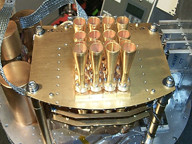ACBAR Home
Science Goals
Instrument Description
Project Team
Press Release
Publications
Data
Photos
Links |
ACBAR Publications
High Resolution Observations of the CMB Power Spectrum with
ACBAR
C.L. Kuo, P.A.R. Ade, J.J. Bock, C. Cantalupo, M.D. Daub, J.
Goldstein, W.L. Holzapfel , A.E. Lange, M. Lueker, M. Newcomb,
J.B. Peterson, J. Ruhl, M.C. Runyan, E. Torbet
We report the first measurements of anisotropy in the cosmic
microwave background (CMB) radiation with the Arcminute
Cosmology Bolometer Array Receiver ACBAR. The instrument was
installed on the 2.1m Viper telescope at the South Pole in
January 2001; the data presented here are the product of
observations up to and including July 2002. The two deep fields
presented here, have had offsets removed by subtracting lead and
trail observations and cover approximately 24 deg^2 of sky
selected for low dust contrast. These results represent the
highest signal to noise observations of CMB anisotropy to date;
in the deepest 150 GHz band map, we reached an RMS of 8.0 uK per
5' beam. The 3 degree extent of the maps, and small beamsize of
the experiment allow the measurement of the CMB anisotropy power
spectrum over the range $\ell = 150-3000$ with resolution of
$\Delta \ell=150$. The contributions of galactic dust and radio
sources to the observed anisotropy are negligible and are
removed in the analysis. The resulting power spectrum is found
to be consistent with the primary anisotropy expected in a
concordance $\Lambda$CDM Universe.
Postscript
preprint of the paper (3.6 MB). Also available at astro-ph/0212289.
Estimates of Cosmological Parameters Using the CMB Angular
Power Spectrum of ACBAR
J. H. Goldstein, P. A. R. Ade, J. J. Bock, J. R. Bond, C.
Cantalupo, C. R. Contaldi, M. D. Daub, W. L. Holzapfel, C. Kuo,
A. E. Lange, M. Lueker, M. Newcomb, J. B. Peterson, D.
Pogosyan, J. E. Ruhl, M. C. Runyan, E. Torbet
We report an investigation of cosmological parameters based on
the measurements of anisotropy in the cosmic microwave
background radiation (CMB) made by ACBAR. We use the ACBAR data
in concert with other recent CMB measurements to derive Bayesian
estimates of parameters in inflation-motivated adiabatic cold
dark matter models. We apply a series of additional cosmological
constraints on the shape and amplitude of the density power
spectrum, the Hubble parameter and from supernovae to further
refine our parameter estimates. Previous estimates of parameters
are confirmed, with sensitive measurements of the power spectrum
now ranging from \ell \sim 3 to 2800. Comparing individual best
model fits, we find that the addition of \Omega_\Lambda as a
parameter dramatically improves the fits. We also use the
high-\ell data of ACBAR, along with similar data from CBI and
BIMA, to investigate potential secondary anisotropies from the
Sunyaev-Zeldovich effect. We show that the results from the
three experiments are consistent under this interpretation, and
use the data, combined and individually, to estimate \sigma_8
from the Sunyaev-Zeldovich component.
A preprint is availible at: astro-ph/0212517
The Arcminute Cosmology Bolometer Array Receiver
M.C. Runyan, P.A.R. Ade, R.S. Bhatia, J.J. Bock, M.D. Daub,
J.H. Goldstein, C.V. Haynes, W.L. Holzapfel, C.L. Kuo, A.E. Lange,
J. Leong, M. Lueker, M. Newcomb, J.B. Peterson, J. Ruhl, G. Sirbi,
E. Torbet, C. Tucker, A.D. Turner, D. Woolsey
We describe the Arcminute Cosmology Bolometer Array Receiver
(ACBAR); a multifrequency millimeter-wave receiver designed for
observations of the Cosmic Microwave Background (CMB) and the
Sunyaev-Zel'dovich effect in clusters of galaxies. The ACBAR
focal plane consists of a 16-pixel, background-limited, 240 mK
bolometer array that can be configured to observe simultaneously
at 150, 220, 280, and 350 GHz. With 4-5' FWHM Gaussian beam sizes
and a 3 degree azimuth chop, ACBAR is sensitive to a wide range
of angular scales. ACBAR was installed on the 2 m Viper telescope
at the South Pole in January 2001. We describe the design of the
instrument and its performance during the 2001 and 2002 observing
seasons.
A preprint is availible at: astro-ph/0303515
|
